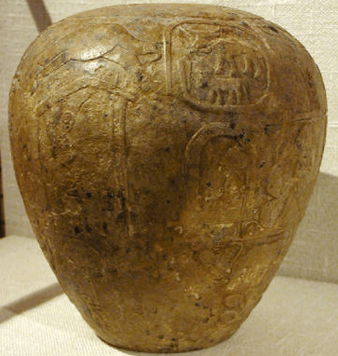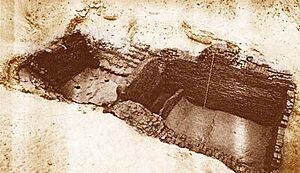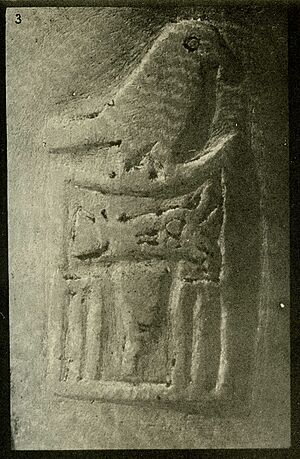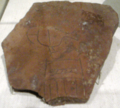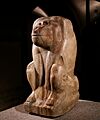Narmer facts for kids
Quick facts for kids Narmer |
|
|---|---|
| Menes(?) | |
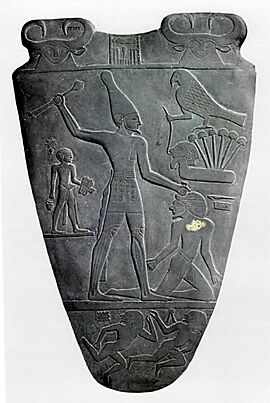
Back of the Narmer Palette
|
|
| Pharaoh | |
| Reign | Somewhere in between 3273–2987 BC (1st dynasty) |
| Predecessor | Ka? |
| Successor | Hor-Aha |
| Consort | Uncertain: possibly Neithhotep |
| Children | Uncertain: probably Hor-Aha |
| Father | Ka?, Scorpion II? |
| Burial | Chambers B17 and B18, Umm El Qa'ab |
Narmer was an ancient Egyptian pharaoh from the Early Dynastic Period. His rule started around 3150 BC. He followed King Ka. Many experts believe Narmer was the first king to unite Egypt. He is also seen as the founder of the First Dynasty.
Narmer also had a strong presence in Canaan, a region near Egypt. This was more noticeable than kings before or after him. Neithhotep is thought to have been his queen or his daughter. Most Egyptologists believe that Narmer was the same person as Menes.
Contents
Who Was Narmer?
Historians often ask two questions: "Who was Menes?" and "Who united Egypt?". Narmer is often given credit for uniting Lower Egypt and Upper Egypt. This happened through a conquest. Menes is traditionally known as the first king or pharaoh of Ancient Egypt. Most Egyptologists think Narmer and Menes are the same person. However, some believe Menes was Hor-Aha, who ruled after Narmer.
The confusion comes from how Egyptian kings were named. "Narmer" is a Horus name. This was a special name linked to the god Horus. "Menes" is a Sedge and Bee name. This was a personal or birth name. Later lists of kings, from the New Kingdom era, mostly show personal names. They usually start with Menes. It is hard to match these lists with older records that use Horus names.
Two important items help us understand this. One is the "Naqada Label." It was found in the tomb of Queen Neithhotep. This label shows Hor-Aha's name next to symbols some think mean "Menes." The second is a seal from Abydos. It shows Narmer's name alternating with a symbol that means "mn," which is short for Menes. These items have led to different ideas about whether Narmer or Hor-Aha was Menes.
However, two special seals found in Abydos are very important. They list Narmer as the first king, followed by Hor-Aha. These seals were found in the tombs of later kings, Den and Qa'a. The seal from Qa'a's tomb lists all eight kings of the First Dynasty in the correct order, starting with Narmer. This strong evidence suggests that Narmer was indeed the first king of the First Dynasty, and therefore, Menes.
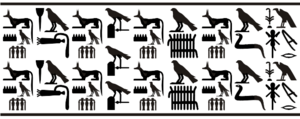

Narmer's Name

Narmer's name is spelled using two hieroglyphs: a catfish (n'r) and a chisel (mr). When put together, they read "Narmer." This name is sometimes translated as "raging catfish." But there are other ideas for what the name means, like "angry," "fierce," or "stinging" catfish. Some scholars have even suggested completely different meanings, but these are not widely accepted.
Often, Narmer's name is shown in a shorter way. It might only have the catfish symbol, sometimes drawn simply. This shorter spelling was used in less formal places, like on pottery or rock carvings. But on important stone carvings or official seals, both symbols are always shown.
Two other ways of spelling Narmer's name have been found. On a mud seal from Tarkhan, a bird symbol was added. This might have meant "Narmer the masculine." However, this extra symbol is rare, so it might not be a true part of his name. Also, two seals from Abydos show his name with a chisel and a symbol that looks like an animal skin. Some think this skin might be a catfish with a bull's tail, like how Narmer is shown on the Narmer Palette.
Narmer's Rule
Narmer's rule is generally thought to have begun around 3100 BC. Other estimates place it between 3273 and 2987 BC.
Uniting Upper and Lower Egypt
The famous Narmer Palette was found in Hierakonpolis. It shows Narmer wearing the crown of Upper Egypt on one side. On the other side, he wears the crown of Lower Egypt. This led to the idea that Narmer united the two lands. Since its discovery, people have debated if the palette shows a real event or is just symbolic. It could be both.
In 1993, a "year label" of Narmer was found. It showed the same event as the Narmer Palette. In the First Dynasty, each year was named after an important event. This label suggests the Narmer Palette shows a real historical event. Most Egyptologists agree with this idea.
Archaeological finds suggest Egypt was partly united before Narmer. Kings like Ka and Iry-Hor (who ruled just before Narmer) may have collected taxes. However, Narmer's name has been found in many more places in Lower Egypt and Canaan. This shows he had a much stronger presence there. The evidence suggests that Narmer finished the unification of Egypt. He did this by conquering a region in the north-west Delta, as shown on the Narmer Palette.
Narmer thought the unification of Egypt was very important. It is shown on the Narmer Palette, a cylinder seal, a year label, and special boxes. The results of this event are also on the Narmer Macehead. Ancient Egyptians also saw this as a huge event. Narmer is listed as the first king on two important seals and in later king lists (as Menes). Even though there were a few kings before Narmer, they are not mentioned in these sources. For ancient Egyptians, history truly began with Narmer and the unification of Egypt.
Egypt's Presence in Canaan
Some ancient writings say that Menes went on a foreign trip and gained fame. If this refers to Narmer, it was likely to Canaan. Narmer's name has been found at nine different sites there. Egypt had a presence in Canaan before Narmer. But during his rule, Egypt's influence there was at its highest. After Narmer, it quickly declined.
During Narmer's time, many Egyptian items were found in Canaan. This included pottery made from Egyptian clay. Also, pottery made from local clay but in the Egyptian style was found. This suggests that Egyptians might have had colonies there, not just trade.
Experts have debated if Egypt's role in Canaan was military or just about trade and colonies. While trade was important, the discovery of forts built in an Egyptian style at Tell es-Sakan shows there must have been some military presence too. Narmer likely did not start Egypt's influence in Canaan with a military invasion. But a military campaign by him to strengthen Egypt's power there is possible.
Neithhotep
Narmer's and Hor-Aha's names were found in what is believed to be Neithhotep's tomb. This led experts to think she was Narmer's queen and Hor-Aha's mother. Her name means "Neith is satisfied." Neith was a goddess from Sais in the Western Delta. This area was conquered by Narmer to complete Egypt's unification. So, some think her marriage to Narmer helped unite the two regions.
Her tomb is in Naqada, in Upper Egypt. This has led some to believe she was from the rulers of Naqada before it became part of united Upper Egypt. The Narmer Macehead might even show their wedding. However, new rock carvings found in Sinai in 2012 have raised questions about whether she was truly Narmer's wife. Neithhotep is likely the earliest non-mythical woman in history whose name we know today.
Narmer's Tomb and Artifacts
Narmer's Tomb
Narmer's tomb is in Umm El Qa'ab near Abydos in Upper Egypt. It has two connected rooms (B17 and B18) made of mud brick. These rooms were identified as Narmer's tomb in 1964. His tomb is next to the tombs of Ka, who likely ruled before Narmer, and Hor-Aha, who ruled after him.
The tomb is over 5,000 years old and has been robbed many times. So, it's amazing that anything useful was found. Because of these disturbances, many of Narmer's items were found in other graves. Also, items from other kings were found in Narmer's grave. However, Flinders Petrie and later the German Archaeological Institute made important discoveries by re-digging the tombs.
Despite the messy state of the cemetery, they found inscriptions on wood and bone, seal impressions, and many flint arrowheads. Flint knives and a piece of an ebony chair leg were also found in Narmer's tomb. These might have been part of his original burial items. It is believed that all kings buried in Umm el-Qa'ab had special enclosures in Abydos' northern cemetery. These were large mud brick areas for funeral ceremonies. One of these unidentified enclosures might have belonged to Narmer.
Narmer's Artifacts
Narmer's name has been found in many places: 98 inscriptions at 26 sites. At Abydos and Hierakonpolis, his name appears both with and without a serekh (a special royal symbol). At most other sites, his name is always in a serekh. In Egypt, his name has been found at 17 sites, including Hierakonpolis, Naqada, Abydos, Tarkhan, and Saqqara.
During Narmer's rule, Egypt had strong trade in southern Canaan. Pottery pieces have been found there. Some were made in Egypt and brought to Canaan. Others were made locally but in the Egyptian style. This suggests Egyptian settlements. Twenty serekhs that might belong to Narmer have been found in Canaan. These came from eight different sites, such as Tel Arad and Tell es-Sakan.
Narmer's serekh has also been found in the Wadi 'Ameyra in southern Sinai. These inscriptions mark Egyptian mining trips to the area.
Nag el-Hamdulab
Rock carvings at Nag el-Hamdulab near Aswan were first noted in the late 1800s. They were rediscovered in 2009. One carving shows a man wearing a crown similar to the White Crown of Upper Egypt. He carries a scepter. He is followed by a man with a fan and two men with flags. A dog is also with them. This scene is like others on the Scorpion Macehead and the Narmer Palette. The man with the crown and scepter is clearly a king. Experts believe this king is Narmer, possibly showing a royal visit or ceremony. However, some scholars think the scene might be from just before Narmer's time.
Images for kids
-
A mud jar sealing showing the contents came from Narmer's estate. From Tarkhan, now at the Metropolitan Museum of Art, New York City.
-
Pottery sherd with Narmer's serekh and name, at the Museum of Fine Arts, Boston.
-
Alabaster statue of a baboon god with Narmer's name carved on its base, at the Ägyptisches Museum Berlin.
See also
 In Spanish: Narmer para niños
In Spanish: Narmer para niños









